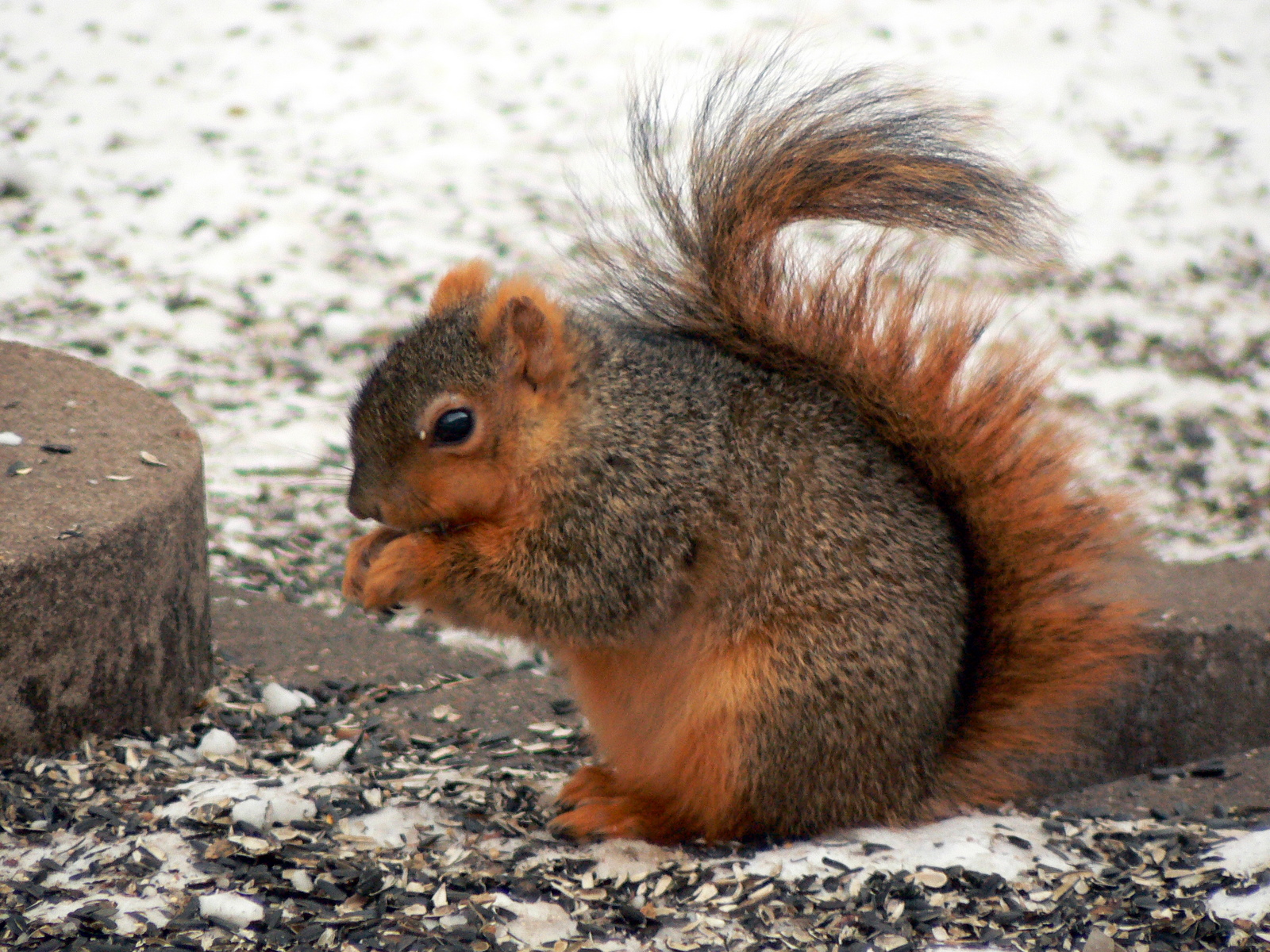As I saw the animal approach me, I froze just like the icicles that frigid morning. Then the thought crossed my mind, what if it tries to climb me like a tree? Luckily it departed shortly after with no such attempt. It did however leave me wondering why did it get so close to me when most encounters with said animal cause it to scurry away?
One thing was made certain in our encounter: which species, or type, of squirrel it was. Year round my current location is inundated with both grey squirrels and fox squirrels—which both have grey fur covering most of their bodies; thus it was essential to see the squirrel’s secondary color for identifying purposes. Perched up next to me on its hind legs, the squirrel provided the perfect opportunity. As it sat there, an orange color was easily detected. Fox Squirrel! To the scientific community it is known as Sciurus niger.
The extent of my encounter with the fox squirrel could not have lasted more than 30 seconds. Taking my usual path on the pavement, the squirrel stopped when approximately one yard away. When I noticed it, I too stopped moving to see what the animal would do. (S)he immediately scurried directly to me and stopped about six inches away. The squirrel appeared to be sniffing around me and then perched up on its hind legs and looked at me. Then it sniffed some more and approached the side of my body and again stood as if waiting for something.
My typical interaction with squirrels does not involve them getting near potential harm. Apparently this distant relationship is common. According to Joseph Moore (1957), “The distance a fox squirrel will run if not hard pressed is rather remarkable. This may be because desirable refuges for such a large tree squirrel are widely scattered”. Moore went on to state that when pursuing a female fox squirrel—now hard pressed, or threatened—she ran 325 meters to safety. Thus one can guess that there must have been a good reason for the squirrel I met to come so close to potential danger. I speculate—in combination with the actions that appeared as sniffing—that the squirrel I encountered may have taken such drastic measures in search of food.
Squirrels, like many other animals, must find a balance between foraging and safety since the extremes can result in death. The extremes are: a squirrel can feed at the maximum rate and ignore safety and likely get killed or it can remain relatively safe in the trees and likely die of starvation (Davies et al., 2012, p.73). Neither extreme is the best solution so it does a mixture of both (Davies et al., 2012, p.73).
Rural squirrels have been shown to exhibit three times the amount of anti-predator behavior (safety behavior) as compared to urban squirrels (MccLeery, 2009). The squirrel anti-predator behaviors investigated included: chattering teeth, freezing all motion, laying down, and scanning. It was also shown that juvenile squirrels ran three times the distance away from a human approach compared to the distance an adult squirrel would run for that same human approach. MccLeery’s finding suggests “that squirrels have a mechanism to adjust their behavior and cope with the constant predator stimuli created by humans in urban environments. Habituation could explain the reduced response to humans by squirrels” (MccLeery, 2009). Furthermore, the differences in fleeing distance in juvenile squirrels suggest that squirrels are not born with one known distance to flee humans. This ambiguous fleeing distance hints at a behavior the squirrel learns with years of encounter, not a skill acquired through genetics.
Therefore, one possibility why the squirrel that crossed my path did so willingly is that urban squirrels may have a certain level of habituation in regards to man.
To test whether fleeing behavior is learned, an experiment can be conducted in which some fox squirrels individuals are raised from birth with absolutely no human contact. Meanwhile, another group of squirrels would experience frequent contact, perhaps during feeding. Then, average fleeing distance from a human would be measured and compared. If the human-visited squirrel runs away at a distance less than that of the isolated group, then fleeing distance is most likely a learned behavior.
In conclusion, it appears that my friendly meeting with the fox squirrel was probably a result of habituation and learned behavior. With so many humans around, (s)he no longer got startled, but probably learned to associate man with food.
References
Davies, N. B., J. R. Krebs, and Stuart A. West. An Introduction to Behavioural Ecology. 4th ed. Oxford: Wiley-Blackwell, 2012. Print.
MccLeery, Robert A. “Changes in Fox Squirrel Anti-predator Behaviors across the Urban–rural Gradient.” Landscape Ecology 24.4 (2009): 483-93. Springer Link. Web. 5 Feb. 2014. <http://link.springer.com/article/10.1007/s10980-009-9323-2>.
Moore, Joseph C. The Natural History of the Fox Squirrel, Sciurus Niger Shermani. N.p.: Bulletin of the American Museum of Natural History, 1957. American Museum of National History. Web. 5 Feb. 2014. <http://hdl.handle.net/2246/1064>.
Photo by Benny Mazur at http://commons.wikimedia.org/wiki/File:Fox_squirrel.jpg


